Top Image: Honouliuli Internment Camp. c. 1945. Photo by R.H. Lodge. Courtesy of the National Park Service.
The lives of Japanese Americans living in Hawaii and along the US West Coast changed following the attack on Pearl Harbor on December 7, 1941. But Japanese Americans in Hawaii lived under significantly different circumstances than those on the mainland.
Former first lady of Hawaii, Jean Ariyoshi, remembered living in fear after the FBI removed her uncle from his house on December 12. Agents suspected him of being a “fifth-columnist,” or subversive operative of Japan, because he was not born in Hawaii nor the United States and, according to popular prejudices of the day, was therefore more loyal to the Japanese emperor than to America. Ariyoshi was held in custody at a local jail while law officials confiscated guns, flashlights, radios, and other instruments that he could potentially use to assist Japanese forces in coordinating a second air attack. Agents informed Ariyoshi that he would be held for approximately a day or two but ended up spending nearly three weeks in an Army internment detention center on Sand Island. His family tried to contact him or at least ask for updates on his condition with no luck.
Ariyoshi was not the only Japanese American on the islands who faced these circumstances following Pearl Harbor. Over 2,000 Japanese Americans spent time in detention because of suspected disloyalty (often with little proof) before their release, while others were rounded up and shipped to the mainland to be held in one of 10 incarceration camps along with the other imprisoned Japanese Americans from the West Coast.
In comparison to the few thousand Japanese Americans detained in Hawaii, after Executive Order 9066 issued by President Roosevelt in 1942 the military removed 120,000 Americans of Japanese descent—most American-born citizens—from their West Coast homes and incarcerated them. While Ariyoshi was eventually released from detention following questioning by FBI agents, Japanese Americans like Miné Okubo and her family were held in the Topaz incarceration camp in Utah for two years, only to be released to discover that they had nothing to return to at home in San Francisco; her father had lost his job and their house had been sold as they could not maintain mortgage payments while they were imprisoned.
Why were the experiences of Japanese Americans in Hawaii different from those like Miné and her family? Japanese Americans made up nearly 30 percent of the population on the islands. Hawaii was initially considered a war zone following Pearl Harbor, yet why were the majority of Japanese Americans there—though subject to heavier surveillance than their White neighbors and, consequently, civil rights violations—not detained long term?
The answer to this question is complex and rooted in Hawaii’s unique racial and ethnic demographics, cultural history, and the implementation of martial law during the war.
Beginning in the mid to late nineteenth century, Hawaii underwent dramatic political and economic shifts. Following an overthrow of the Hawaiian royal kingdom, orchestrated by wealthy Whites interested in lowered tariffs, and the United States’ annexation of the islands in 1900, sugar cane became a key crop for White plantation owners. These vast, agricultural operations required an enormous amount of physical labor, and the planters turned to importing workers from around the world to meet demands. Puerto Ricans, Chinese, Portuguese, Filipinos, and some African Americans arrived in Hawaii to harvest the sugar crops alongside many of the idegenous Hawaiians and Samoans, leading to an ethnically and racially diverse population.
Japanese immigrants were also part of this wave of migration to the islands. Under the Meiji Restoration (or a return to rule of the emperor rather than the warrior shogunate) during the late nineteenth century, the Japanese government loosened restrictions on migration to the United States. Thousands of Japanese took advantage of this change in policy and came to Hawaii to work on the plantations. Japanese immigrants also came to the mainland West Coast during the early twentieth century, but the reception and experiences of the two groups were different.
While Japanese easily filled a need for agricultural labor on the plantations and did not come into direct economic competition with White political elites, merchants, or other white collar laborers, Japanese on the West Coast quickly established themselves as successful farmers—competing with White farmers for land and access to local and regional markets. The extreme levels of anti-Japanese sentiment on the West Coast that produced discriminatory laws that forbade Japanese immigrants from owning property on the mainland did not exist in Hawaii. Under these more relaxed conditions, Japanese Hawaiians were able to move into middle class occupations and, by 1941, establish themselves economically.
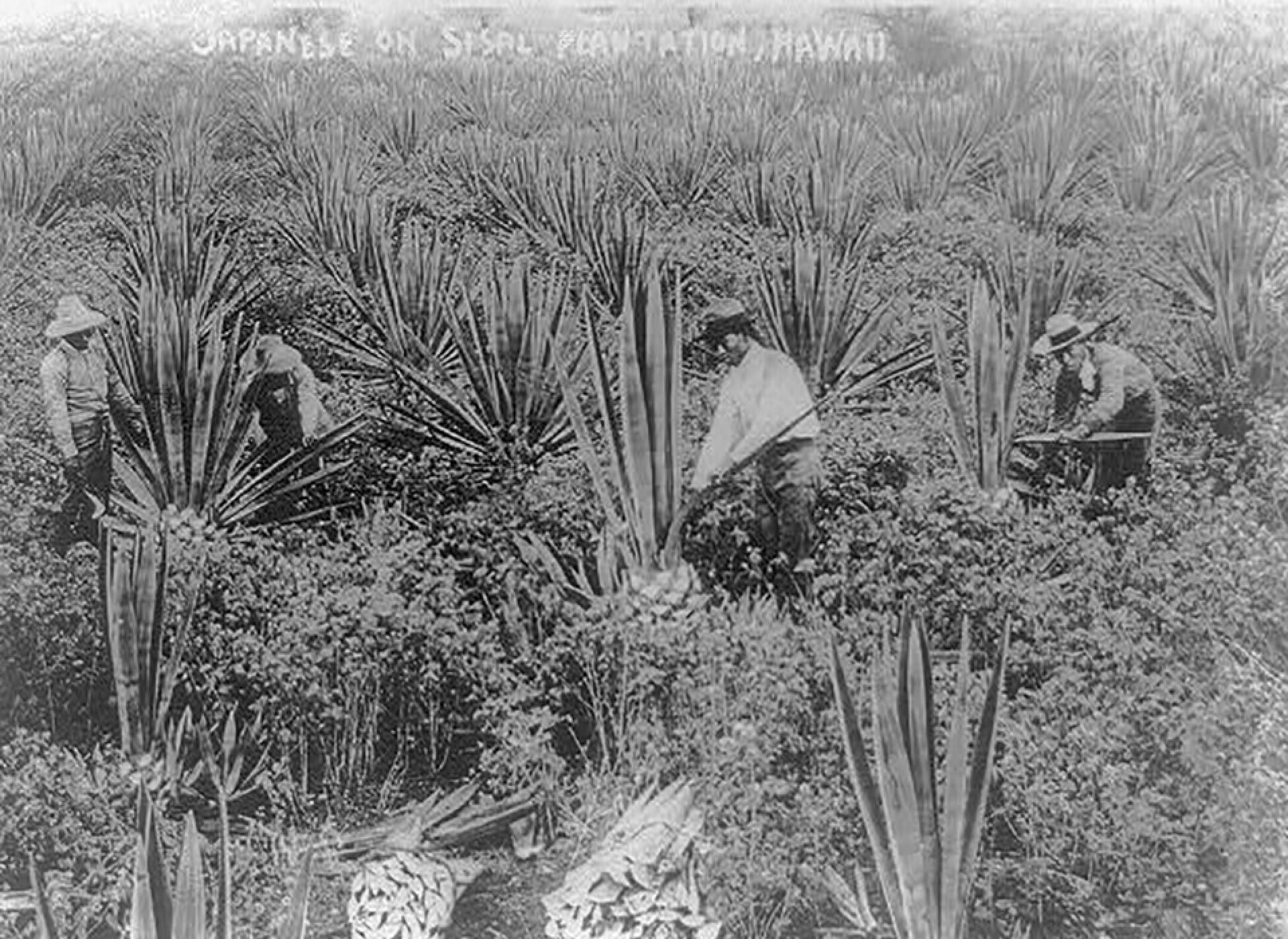
Japanese on Sisal Plantation in Hawaii, c. 1910. Courtesy of the Library of Congress.
Hawaii was not without its prejudices and while it would be a stretch to describe the islands as completely racially harmonious, the racist societal norms and laws that defined areas of the United States did not exist at such levels and in such strict forms. Historians describe Hawaii as being subjected more to class and economic prejudices than racial or ethnic ones (though these are not entirely mutually exclusive for a region consisting of wealthy sugar planters who relied heavily upon ethnic and racial minorities for their labor), and prejudiced beliefs against ethnic groups were often restricted to social norms rather than enforced by laws or regulations.
Because of a lack of a strict, legally-sanctioned racial hierarchy on the islands, Japanese American families were often friends and business partners with Whites, and the Nisei (or second generation Japanese American) identified as American rather than Japanese, attending integrated schools alongside their White counterparts. The fact that Whites were in the minority on the islands and Japanese Americans were the largest ethnic Asian group (making up 37 percent of the demographics) also ensured that West Coast levels of racial anxiety and discrimination were kept at bay in Hawaii. Whites may not have fully accepted Japanese as “Americanized,” but they were relatively tolerant of their place in Hawaiian society.
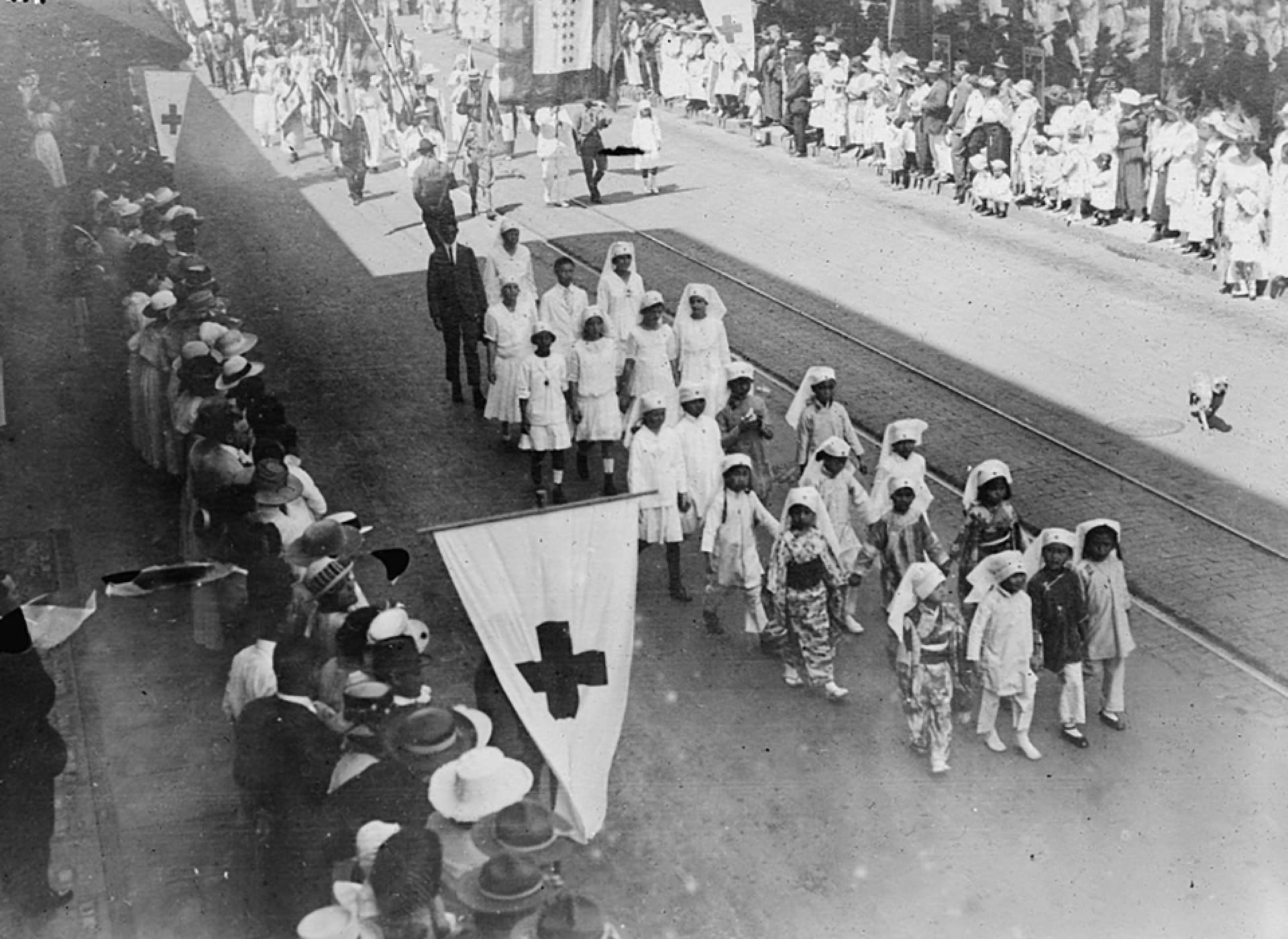
Chinese and Japanese children marching in a Junior Division American Red Cross Parade in Honolulu in 1918. Courtesy of the Library of Congress.
But the Pearl Harbor attack challenged these established relationships between Japanese Americans and Whites. White reactions to Japanese Americans whom they had known for years (sometimes decades) varied from steadfast friendship to outbursts of anger and paranoia. Though the levels of suspicion and outcries against the Japanese Americans were not as extreme as those along the West Coast after December 7, 1941, the Japanese American community on the islands contended with prejudiced ideas about their loyalty. Many white Hawaiians believed that though not inherently disloyal, 90 percent of the 160,000 Japanese there were “on the fence” in the days following the Pearl Harbor attack depending upon which way the war would go in the next few months. Still, as historians Beth Bailey and David Farber note, many island residents easily made the distinction between citizens of Japan and the people of Japanese descent in Hawaii.
Nevertheless, Japanese Americans displayed their patriotism and dedication to the war cause. Community leaders initiated “Speak English” campaigns and avoided publicly speaking in Japanese. This extended into removing Japanese language signs for businesses (or changing names of businesses to English names), destroying Japanese-language books or materials, and discontinuing Japanese celebrations. These tasks were not difficult for the islands’ Nisei population who saw themselves as thoroughly Americanized as their White friends and classmates. Japanese Americans went above and beyond in displays of patriotism by buying war bonds, donating blood, and participating in other volunteer opportunities for the war effort.
Nisei students who were ROTC members at the University of Hawaii also joined other classmates as part of the Hawaiian Territorial Guard (HTG), but the Army later ordered Nisei dismissed from the HTG because of the dissonance between declaring Japanese Americans as potentially subversive while also providing them with access to firearms. In response, some of the Nisei—who received a draft classification as enemy alien at the time—formed the Varsity Victory Volunteers (VVV). The VVV was a voluntary labor battalion for the Army’s 34th Engineers (as well as instrumental to the formation of the 442nd Regimental Combat Team) responsible for construction and infrastructure projects at Schofield Barracks on Oahu.
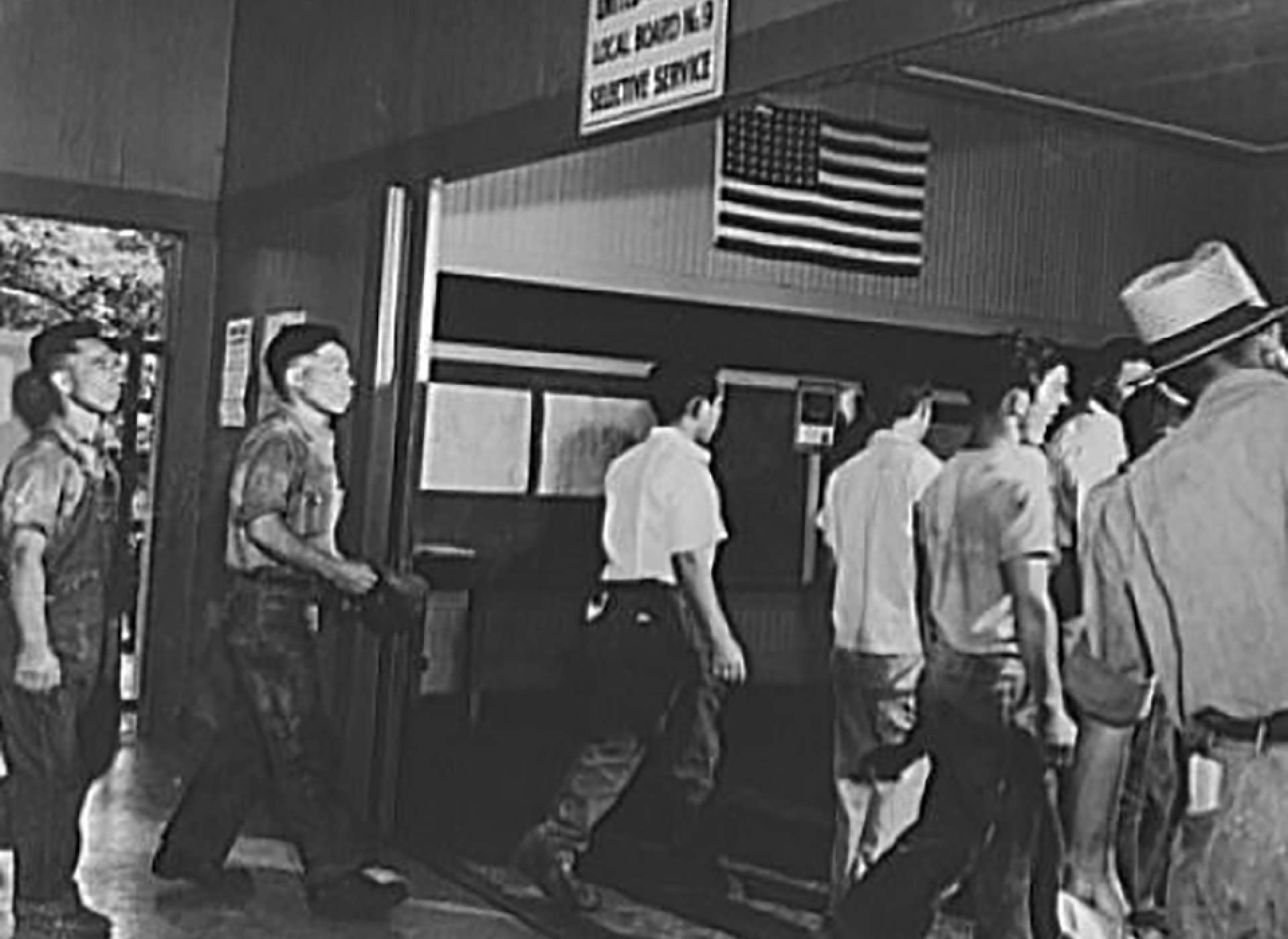
Japanese Americans line up to enlist in the Army in 1943. Courtesy of the Library of Congress.
But Japanese Americans on the mainland participated in similar activities and were still unable to avoid mass removal and incarceration. Did Japanese American displays of patriotism in Hawaii create a different wartime experience? Not necessarily.
The military’s assessment of the situation in Hawaii and the decision to place its habitants under martial law had perhaps more of a role in avoiding mass incarceration than the individual or community actions of Japanese Americans. Well before the Pearl Harbor attack, there were contingent plans in place to declare military control should the islands be invaded by Japan or any other force. In the fall of 1941, General Walter Short, then leader of the Hawaiian command of the Army, requested legislative support for a quick and efficient enactment of military governance in the event of an attack following rising tensions across the Pacific.
These plans included Commander of the Hawaiian Department of the Army assuming the position of military governor, the suspension of writ of habeas corpus, and the move to military rather than civil courts (not to mention whatever other measures declared necessary for protection of the islands). Within hours of the attack on Pearl Harbor, General Short had convinced Governor Poindexter to declare military rule, placing Short in charge and making him Hawaii’s first military governor. His tenure did not last long, however, as his earlier decisions before the attack on Pearl Harbor led to his dismissal. General Delos Emmons (earlier chief of the Air Force Combat Command) replaced Short as military governor of Hawaii 10 days after Pearl Harbor.
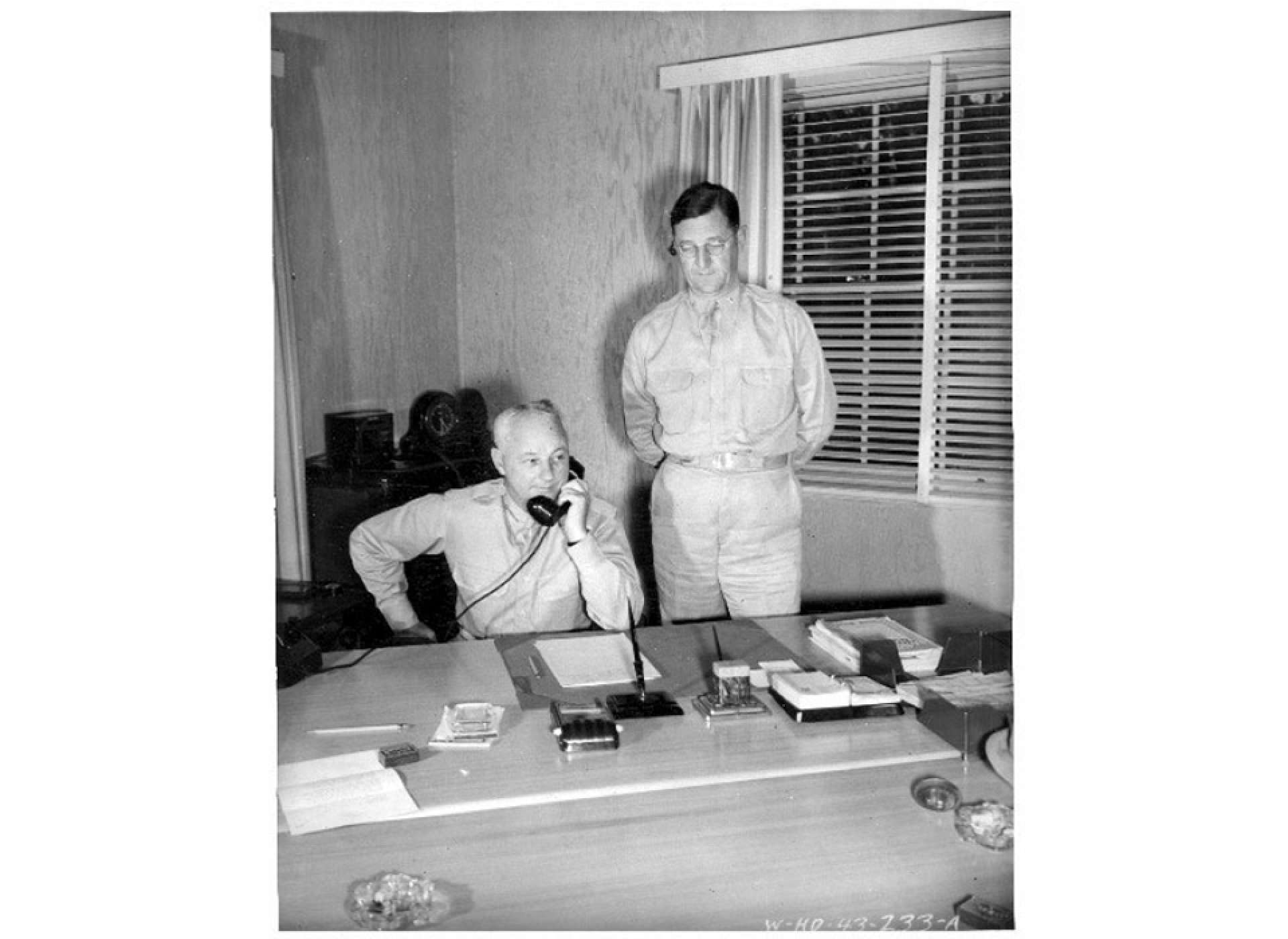
General Delos Emmons at the Office of Military Governor in Honolulu, 1943. Courtesy of Densho.
Emmons proved to be skeptical of the need to remove and detain all 160,000 of Hawaii’s Japanese population. Whereas FDR was ready to write orders declaring a removal and detention process (removing all Japanese Americans on Oahu to the outermost islands as well as some of the camps on the mainland), Emmons rejected this notion. Rumors that a mass evacuation was coming swept through both White and Japanese American communities in Hawaii, but Robert Shivers (head of the Hawaii branch of the FBI) confirmed that not all 160,000 Japanese Hawaiians were security risks and convinced Emmons that mass detention was unnecessary.
On December 21, Emmons made a radio announcement to the people of Hawaii in hopes of dispelling fears and rumors:
“There is no intention of desire on the part of the federal authorities to operate mass concentration camps…While we have been subjected to a serious attack by a ruthless and treacherous enemy, we must remember that this is America and we must do things the American Way. We must distinguish between loyalty and disloyalty among our people.”
While Secretary of War Henry Stimson requested the detention of “all of the Japs”—regardless of whether they were in Hawaii or on the mainland—Emmons attempted to stall any decision in favor of such a drastic measure.
Was it simply Emmons’ belief in the loyalty of Japanese Americans that prevented mass detention in Hawaii? Emmons’ decisions were more calculated than simply supporting good, loyal, and Americanized Japanese against racist and prejudiced attacks. He was concerned about the logistics of removing and detaining Hawaii’s Japanese American population. Forcing 160,000 people from their homes to the mainland was overwhelming and nearly impossible (in the end more than 400 Issei and Nisei as well as a dozen German and Italian nationals were sent to the mainland for detention). Additionally, if 37 percent of Hawaii’s population was removed, this would have a devastating effect on the islands’ wartime economy and, as a result, the American war effort. Japanese Americans were needed in Hawaii to fill wartime needs.
And, as historians have pointed out, martial law itself made the need for detaining all Japanese unnecessary; under military government all of Hawaii’s population was subject to certain measures and restrictions. Hawaiian occupants were fingerprinted and registered within the military government’s immense bureaucratic system. They were required to carry identification cards at all times and were subject to curfews, blackouts, and censorship. Jury trials were suspended and replaced with military courts. Travel was restricted for most inhabitants.
Under these conditions, Hawaii was not a democracy; it was a military fortress. Emmons was able to squash any sort of mass hysteria like that on the mainland, whereas (as historian Rich Frank notes) West Coast residents who held racist beliefs toward Japanese and saw them as subversives could petition to their representatives or publish op-eds to sway popular opinion as part of the traditional, democratic process. Emmons was able to declare that Japanese Americans were not a threat and would not be removed because, as military governor, he could.
However, this did not mean that Japanese Americans in Hawaii did not live with extra scrutiny or under more severe and restrictive measures. The notion that Japanese Americans were predisposed to disloyalty more than other enemy aliens still shaped martial law and the views of both military and local officials. In addition to the general restrictions and curfews, Japanese Americans were also prohibited from fishing, one of the main livelihoods for the community. The Japanese American community was also subjected to more unconstitutional searches and seizures than other groups. More than 10,000 Japanese Americans were arrested and interrogated during the war, leading to fear among the Japanese community that they could also be taken into custody at any time with little proof of any subversive activities.
It’s a misconception that no Japanese Americans were detained in Hawaii during the war or that all Hawaiians were subjected to the same intense scrutiny as that which Jean Ariyoshi’s uncle experienced. But it’s undeniable that Japanese Americans in Hawaii and those on the mainland had different experiences with detention and incarceration that stemmed from the social, cultural, political, and military histories of both locations. The threat of a Japanese invasion declined sharply after the American victory at the Battle of Midway and martial law in Hawaii ended by 1944, but the war left its mark on Japanese Americans on the islands.
Stephanie Hinnershitz, PhD
Stephanie Hinnershitz is a historian of twentieth century US history with a focus on the Home Front and civil-military relations during World War II.
Cite this article:
MLA Citation:
APA Citation:
Chicago Style Citation:
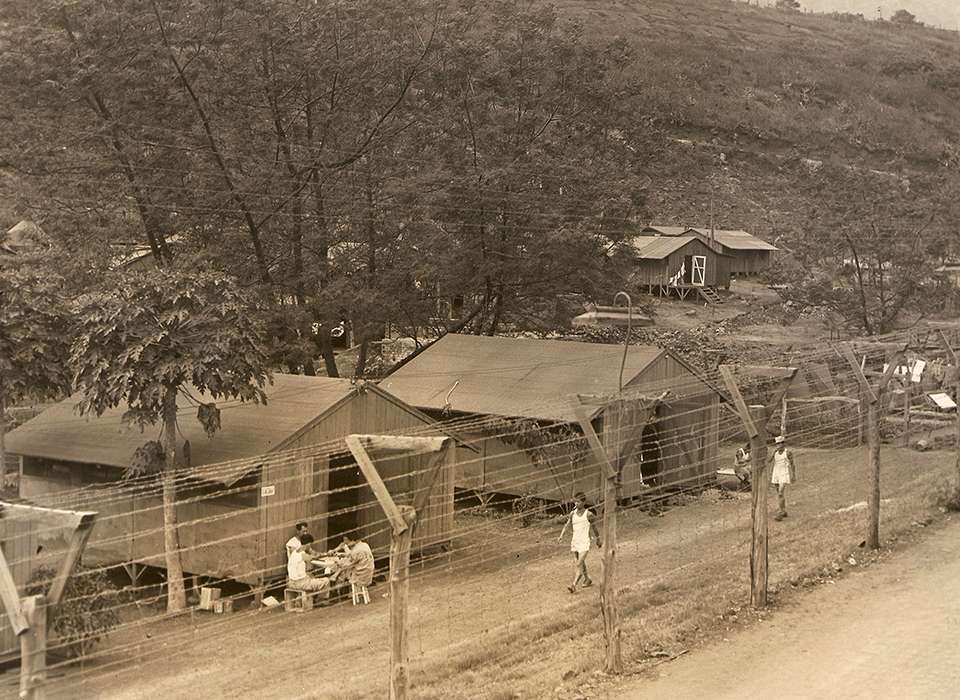





![Max Fuchs, New York City cantor, sings as Rabbi Sydney [sic] Lefkowitz, Richmond, VA, conducts the first Jewish services from Germany.](/sites/default/files/styles/max_650x650/public/2025-10/image1.jpg)


